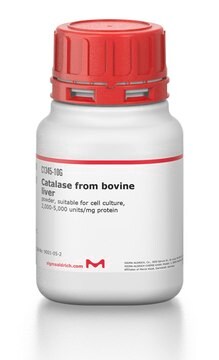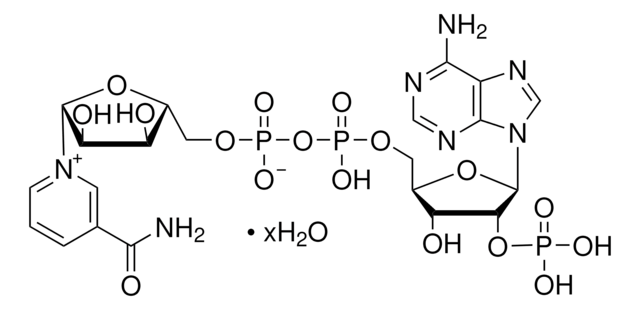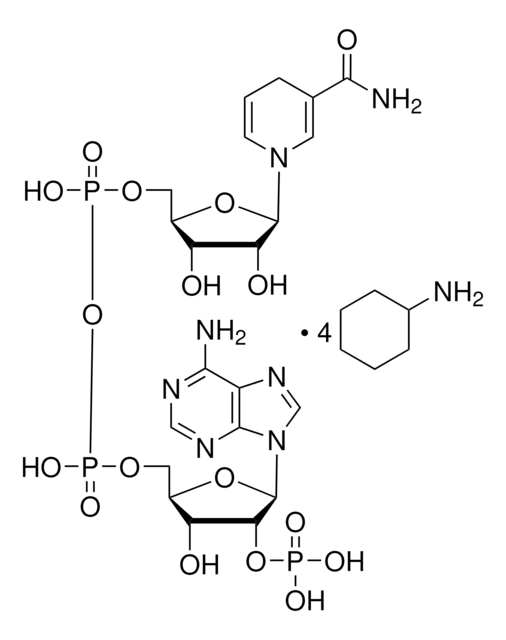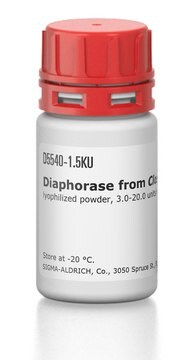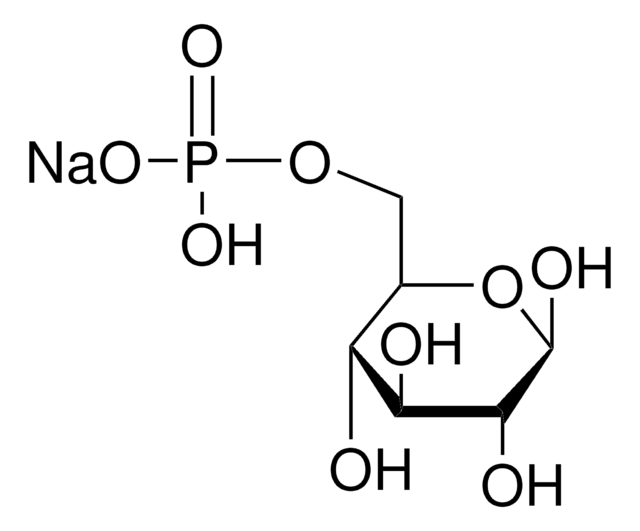F0628
Ferredoxin-NADP+ Reductase from Spinacia oleracea (spinach)
lyophilized powder, ≥15 units/mg solid, secondary activity: ≥10 units/mg solid NADPH diaphorase
Synonym(s):
Ferridoxin-NADP+ oxidoreductase
Sign Into View Organizational & Contract Pricing
All Photos(1)
About This Item
CAS Number:
MDL number:
UNSPSC Code:
12352204
NACRES:
NA.54
Recommended Products
form
lyophilized powder
Quality Level
specific activity
≥15 units/mg solid
foreign activity
NADH diaphorase activity ≤10 units/mg solid
storage temp.
−20°C
General description
Ferredoxin-NADP+ Reductase is a ferredoxin-soluble partner with a molar ratio to PSI of 0.9 and 3.
Application
Ferredoxin-NADP+ Reductase from Spinacia oleracea (spinach) has been used to test the effect of potential protein partners on the activity of the glyceraldehyde-3-phosphate dehydrogenase (GAPDH)−CP12 preparation. It has also been used in standard assay conditions for phycocyanobilin:ferredoxin oxidoreductase (PcyA) enzyme assay.
Ferredoxin-NADP+ Reductase was used in in vitro ferredoxin-dependent desaturation of fatty acids in cyanobacterial thylakoid membranes. It was also used to regulate glyceraldehyde-3-phosphate dehydrogenase.
Biochem/physiol Actions
Ferredoxin-NADP+ reductase catalyzes the reversible conversion of reduced ferredoxin to oxidized ferredoxin during photosynthesis. Ferredoxin-NADP(H) reductase constitutes a family of hydrophilic FAD-containing monomeric enzymes that deliver NADPH or low potential one-electron donors to redox-based metabolisms in plastids, mitochondria, and bacteria.
Ferredoxin-NADP+ reductase catalyzes the reversible conversion of reduced ferredoxin to oxidized ferredoxin during photosynthesis. Ferredoxin-NADP(H) reductase constitutes a family of hydrophilic FAD-containing monomeric enzymes that deliver NADPH or low potential one-electron donors to redox-based metabolisms in plastids, mitochondria, and bacteria.
Unit Definition
One unit will reduce 1.0 millimole of cytochrome C per min at pH 7.5 at 25 °C in the presence of spinach ferredoxin and NADP.
Storage Class
11 - Combustible Solids
wgk_germany
WGK 3
flash_point_f
Not applicable
flash_point_c
Not applicable
ppe
Eyeshields, Gloves, type N95 (US)
Certificates of Analysis (COA)
Search for Certificates of Analysis (COA) by entering the products Lot/Batch Number. Lot and Batch Numbers can be found on a product’s label following the words ‘Lot’ or ‘Batch’.
Already Own This Product?
Find documentation for the products that you have recently purchased in the Document Library.
Customers Also Viewed
A Conserved Histidine-Aspartate Pair Is Required for Exovinyl Reduction of Biliverdin by a Cyanobacterial Phycocyanobilin:Ferredoxin Oxidoreductase
Tu SL, et al.
The Journal of Biological Chemistry, 281(6), 3127-3136 (2006)
Néstor Carrillo et al.
European journal of biochemistry, 270(9), 1900-1915 (2003-04-24)
Ferredoxin (flavodoxin)-NADP(H) reductases (FNR) are ubiquitous flavoenzymes that deliver NADPH or low potential one-electron donors (ferredoxin, flavodoxin) to redox-based metabolisms in plastids, mitochondria and bacteria. The plant-type reductase is also the basic prototype for one of the major families of
Glyceraldehyde-3-phosphate dehydrogenase is regulated by ferredoxin-NADP reductase in the diatom Asterionella formosa
Mekhalfi M, et al.
The New phytologist, 203, 414-423 (2014)
Ferredoxin-NADP+ Reductase KINETICS OF ELECTRON TRANSFER, TRANSIENT INTERMEDIATES, AND CATALYTIC ACTIVITIES STUDIED BY FLASH-ABSORPTION SPECTROSCOPY WITH ISOLATED PHOTOSYSTEM I AND FERREDOXIN
Cassan N, et al.
The Journal of Biological Chemistry, 280(28), 25960-25972 (2005)
Min Seok Cho et al.
Journal of microbiology (Seoul, Korea), 50(3), 496-501 (2012-07-04)
The Gram-positive bacterium Clavibacter michiganensis subsp. michiganensis is the causal agent of canker disease in tomato. Because it is very important to control newly introduced inoculum sources from commercial materials, the specific detection of this pathogen in seeds and seedlings
Our team of scientists has experience in all areas of research including Life Science, Material Science, Chemical Synthesis, Chromatography, Analytical and many others.
Contact Technical Service






